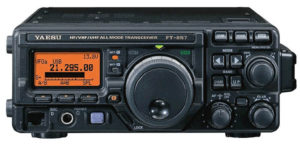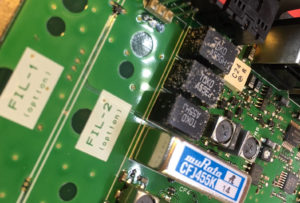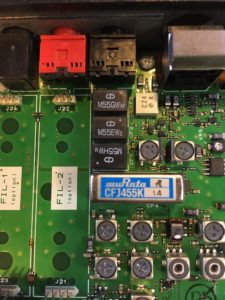 The Yaesu FT-897 has been around since about 2002…they’ve sold thousands of them and they are still popular today. The FT-897 is pretty much a ‘shack in a box’ covering all the HF bands plus 6,2 and 70. Yaesu, at the time of writing, still have all the details on their website here…so I won’t list them in this post. I think it’s a great radio for the money; you can buy a matching auto ATU, internal power supply, dual internal batteries, optional filters and lots of other accessories. Personally I find it works very well on the air too. They currently have a 4.6 out of 5 review rating at eham which you can read here.
The Yaesu FT-897 has been around since about 2002…they’ve sold thousands of them and they are still popular today. The FT-897 is pretty much a ‘shack in a box’ covering all the HF bands plus 6,2 and 70. Yaesu, at the time of writing, still have all the details on their website here…so I won’t list them in this post. I think it’s a great radio for the money; you can buy a matching auto ATU, internal power supply, dual internal batteries, optional filters and lots of other accessories. Personally I find it works very well on the air too. They currently have a 4.6 out of 5 review rating at eham which you can read here.
In common with many Yaesu radios, and in fact those of Kenwood, ICOM etc., the FT-897 has several small ceramic filters installed made by TOKO; three in the FT-897. Chances are, if you have one of these radios, the filters will either be failing or have been replaced by now. If you’re contemplating a second hand one, I’d make sure the filters have been done or you will be faced with a bill at some point. Yaesu may be able to tell you, if you let them have the serial number of your radio, if your FT-897 is likely to suffer in the future; I suspect some of the last ones sold may be safe, but can’t be sure.
There is a great deal of information, and misinformation, about the ceramic filter problem so I’ll put the record straight here.
What are the symptoms of faulty ceramic filters?
They vary from radio to radio. Normally the problem starts with what sounds like loud static crashes…but they are still there with the radio unplugged. Sometimes the radio just becomes very deaf. Pop the top cover off and you’ll soon see if the filters are suspect.
Why do the filters fail?
 The myth popular on the internet is that the small DC voltage being applied to the filters is causing them to fail. People are replacing the filters and installing DC blocking capacitors and of course this works.
The myth popular on the internet is that the small DC voltage being applied to the filters is causing them to fail. People are replacing the filters and installing DC blocking capacitors and of course this works.
However, the filter catalogues and data sheets all say that a small DC voltage will not harm the filter in any way. I also think it’s unlikely that Yaesu, ICOM and Kenwood engineers collectively got it wrong.
If you look at the ceramic filters in a faulty radio, they will be covered in a white salt-like deposit. If you break open the filter cases, you will find a turquoise deposit inside. The plastic that the filter housings are made from is hygroscopic; i.e. it absorbs moisture…which it then releases when it warms up. It then absorbs more when it cools down and the cycle continues until the turquoise copper compound shorts out the filter’s internal structure.
So…it’s down to hygroscopic TOKO plastic…not DC voltage; the electrons are innocent!
It doesn’t matter if the radio has been kept in a warm dry house either; the filters will still eventually fail.
Replacing the filters
The filters themselves are small, but the surrounding surface mount components are 0402 size; just 1 mm by 0.5 mm. They are easily damaged…I managed to catch a 470 ohm resistor near one filter which I had to replace.
Unless you really are familiar with this sort of work, I’d rely on Yaesu or a trusted repair shop to do this for you. Here’s my hint though…with a pair of flat nose pliers, gently crack open the filter cases and remove the filter elements; it reduces the heat capacity and makes removal of the filters much easier. I also used a Weller desoldering station with a fine nozzle…and still caught a tiny resistor.
I’ve no intention of fitting any blocking capacitors by the way…if you wish to carve up your FT-897 main board, please crack on.
Where to get the filters?
 Personally, I got mine from Yaesu…they are really cheap from them and hopefully Yaesu have sought a more reliable source than TOKO. I got four sets; one for now, one for later ‘just in case’ and two in case any friends need a repair. I’ve often found some parts become impossible to find when they go obsolete.
Personally, I got mine from Yaesu…they are really cheap from them and hopefully Yaesu have sought a more reliable source than TOKO. I got four sets; one for now, one for later ‘just in case’ and two in case any friends need a repair. I’ve often found some parts become impossible to find when they go obsolete.
I’m sure there are many good sources on sites such as eBay; maybe you’ll have to buy ten or someone will supply a kit. I do worry however that some eBay filters are counterfeit, some may be hygroscopic like the TOKO originals or they simply may not be very good. You pays your money and takes your choice I suppose.
Here’s an image of the main board with the new filters from Yaesu installed; obviously there are no white deposits. As far as the pesky 1 x 0.5 mm resistor is concerned, all I can say is ‘illuminated magnifier, cocktail sticks, solder paste and a really fine tip’. Luckily I have a good steady hand. Now, I’d better check out the FT-817 hadn’t I…